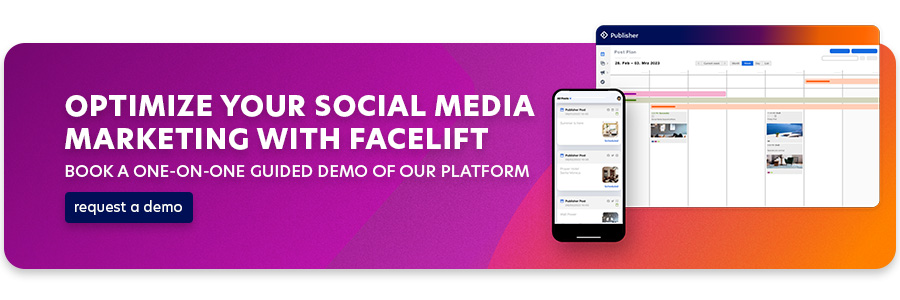For businesses, especially those looking to scale their efforts internationally or across multiple offices, it's not sufficient anymore to simply have a presence on the major social media platforms and hope for the best.
Today, it's about leveraging them to their fullest potential. This is where advanced social media analytics come into play, transforming raw data into a goldmine of strategic insights, and it just so happens that Facelift leads the way in this data arena.
The social media analytics status quo
Success on social media used to be measured by the number of likes or shares that a page or post managed to eke out of its followers, but these metrics barely scratch the surface. They're important, and we've talked about them before, but for businesses with mature social media presences who need to leverage their reach in a more strategic way, we need to dig deeper.
Both social media managers and organizational leaders alike need to understand the nuances of audience engagement, the actual applications of content performance, and the dynamics of online conversations to fuel their brand narratives.
This is not just about numbers; it's about narratives! These narratives empower business leaders to move beyond reactive tactics to proactive social media strategies, shaping content that resonates with an audience that cares, campaigns that convert the right people, and interactions that work to sustain customer affinity and retention in the longer term.
How analytics inform decision-making
Advanced analytics provides you and your social media campaigns with that strategic edge you need, and we've made it our business to help you find the right tools for the job. With Facelift, you can turn deep, detailed social media data from your own pages and those of your competitors into actionable insights that drive decision-making.
But before you invest in social media tools, the first step is to know your needs and proper planning. But how exactly does this work in the context of social media?
Understanding audience dynamics:
This isn't exactly a new concept. Marketers have known that understanding an audience is essential for as long as marketing has existed.
However, more advanced analytics can reveal insights into your audience's online behavior. Most data and reporting tools will give you basic social media data such as peak activity times, content preferences, and interaction types (likes, shares, comments, etc.), but there's a layer missing.
This concept analyzes what it is that your followers, users, or buyers are actually doing. We want to know their journeys, their decisions, and how they impact their user journeys as they interact with your company and product or service.
Seem like a lot? It is, and there's so much you can do in this area, but there are two basic things you can do now:
- UTM parameters: "Urchin Tracking Meters" are small snippets of text that you embed in the URL of a piece of content, such as a blog or white paper. They allow your content management system (CMS) or another analytic tool to analyze clicks on certain links and help you trace their origin. UTMs are very important for social media content because certain analytics platforms, such as Google Analytics, cannot directly track traffic from specific social media pages, meaning it can be difficult to know exactly which page(s) your website visitors are coming from. Here's a great article from HubSpot that explains how UTMs work.
- Segmentation: This process involves dividing your social media audience into smaller groups based on shared characteristics like age, location, interests, or behavior. This approach allows for more targeted and relevant content, advertising, and engagement strategies. Most large companies will already have these groups isolated, so working with the data to select or create the right social media content should be something you can do right now.
If these things sound like a lot of work, don't worry; they're actually not so hard to do. You can do much of this manually by using spreadsheets or even a whiteboard. UTMs can be made relatively simply by most CMSs.
However, if you want to dig deeper and manage these tasks and others in one place, Facelift is the right place to go. Set up an appointment with one of our product experts and ask about segmentation and UTMs. They'll be happy to explain how we can help you manage both!
Refining your content strategy:
Every piece of content you publish is a chance to engage with your audience. Many people think that "engagement" refers only to manual actions that users take on your page (...likes, shares, etc...), but it can be a lot more than that. A simple view of a blog article or a click on your website that results in scrolling events (literally when they scroll through the page scanning it for something) can both be "events" that constitute engagement.
Remembering how social media fits into your company's overall content strategy is important.
Content strategy does not, contrary to popular belief, refer to the editorial calendar of your content marketing team. It refers to the strategic use and maintenance of web materials to meet business goals, and it is designed (or it should be designed) to span the entire customer lifecycle.
This means social media needs to be a part of your content strategy. It means thinking about how the content you produce fits into your overall business goals, and assessing accurately whether your existing content is actually doing this. It's all too easy just to start spamming whatever seems like it might be a good fit for Instagram without putting enough critical thought into it.
As for your editorial, that comes second. By working with tools like Facelift, you can take advantage of detailed, advanced analytics to help you determine which types of content generate the most engagement, whether it's video, long-form articles, or quick updates.
Furthermore, they can reveal why certain content is successful, enabling you to replicate that success and avoid past mistakes.
Optimizing campaign performance:
Launching campaigns without leveraging social media analytics is like sailing without a compass. Your data provides insights into what's working and what's not, enabling you to adjust your campaigns and processes in real-time. These changes could include anything but frequently involving tweaking your messaging, shifting your budget to more effective channels (for example, paid advertising or post promotion), or even redefining your target demographics based on response rates.
Social media never stands still, and the people who use it don't either. This is why no social media campaign can really just be a case of "set and forget". After all, this is why you hired dedicated personnel to handle it, right?
Predictive analysis:
Predictive analytics in social media involves using historical data, algorithms, and machine learning techniques to forecast future trends, behaviors, and outcomes. This process starts with collecting and analyzing vast amounts of past social media data, including user interactions, engagement patterns, and content performance.
Predictive models can be developed by identifying trends and patterns in your social media data. These models are then used to make informed predictions about future user behavior, such as which types of content are likely to generate the most engagement during a specific time frame or event, the best times to post for maximum visibility, or how audience preferences might evolve given changes in a social or political climate.
It can also help to identify emerging trends before they become mainstream. This foresight enables businesses to proactively adjust their social media strategies, optimize content creation, and stay ahead of the competition. Predictive analytics tools often incorporate machine learning, meaning they continuously learn and improve from new data, making their predictions more accurate. This makes them an invaluable asset for businesses looking to strategically enhance their social media presence and engagement.
Some of the top tools for predictive analytics in social media include:
-
Google Analytics Predictive Metrics: By analyzing user behavior on your website, Google Analytics offers predictive insights, such as potential revenue from a customer segment. This can be particularly useful when integrated with social media data.
-
IBM Watson Analytics: Known for its advanced AI capabilities, IBM Watson Analytics provides predictive insights and helps in identifying trends and patterns in social media data.
-
HubSpot: While primarily a CRM tool, HubSpot offers advanced analytics and can be used for predictive lead scoring, helping to determine which leads from social media are most likely to convert.
- Facelift: Powered by our market-leading social media analytics tool quintly, Facelift is your powerful companion in predictive analysis. No other tool on the market features the depth or completeness of quintly's data processing, benchmarking, and reporting capabilities.
Key advanced metrics to watch
Not all metrics are created equal. While basic metrics like likes and shares provide a surface-level view, advanced metrics offer a window into the deeper impact and effectiveness of your social media efforts.
Here are some key advanced metrics that are essential for a nuanced understanding of your social media strategy:
Engagement rate:
This is about understanding how engaged your audience is with your content, not simply whether engagements are happening or not. The engagement rate considers the number of active interactions (likes, comments, shares) relative to your total followers or reach, offering a more accurate measure of how your content resonates with your audience.
Conversion rate:
Especially crucial for businesses, this metric tracks how many users take a desired action (like making a purchase or signing up for a newsletter) after interacting with your social media content. It's a direct indicator of the ROI of your social media efforts!
Customer sentiment:
This advanced metric analyzes the tone and context of social media conversations about your brand. Tools that offer sentiment analysis can categorize mentions as positive, negative, or neutral, giving you a clearer picture of your brand's public perception. One way to gauge your followers and the market, in general, is with Talkwalker's powerful social listening capabilities.
Share of voice:
This measures how much of the online conversation in your industry is about your brand compared to competitors. It's a valuable metric for understanding your brand's position in the market and identifying opportunities to boost your visibility.
Follower growth rate:
Instead of just looking at the number of followers, this metric focuses on the rate at which your follower base grows. It helps gauge the long-term sustainability of your social media strategy and is a good indicator of how your content performs among your existing fans.
Click-Through Rate (CTR):
CTR measures the effectiveness of your social media content in driving traffic to your website or landing page. It's crucial for evaluating the success of specific calls-to-action and promotional content.
Use these metrics to determine the successes and trajectories of your social media campaigns. Analytics data that provides these insights can be found on most social media platforms natively, and all of them can be accessed in one place with Facelift's reporting capabilities.
Conclusion
Remember, the goal is not just to collect data, but to use it strategically. Whether it's tailoring content to specific audience segments, refining your campaigns based on real-time feedback, or predicting future trends, the insights you can get from your social media analytics data are invaluable.
These insights will empower your business to make informed decisions, create more engaging and effective content, and ultimately, build stronger connections with your audience.
Facelift can help you with this journey! Our state-of-the-art platform offers an all-in-one solution that meets the needs of organizations at scale. It is particularly tuned to managing multiple pages and helping with collaboration across teams.
Schedule a demo with our product experts and find out why Facelift should be part of your tec stack!






